KRLA and the Beat history
KRLA personalities
KRLA specialties
The times they are a-changin'
 It's
always good to move forward, and that's exactly what the KRLA Beat did in February 1965. This old-format
newsletter was about to be replaced by something new, and not a moment too soon.
It's
always good to move forward, and that's exactly what the KRLA Beat did in February 1965. This old-format
newsletter was about to be replaced by something new, and not a moment too soon.
Bonnie Golden's heyday as editor was about to be supplanted by a new publication with an updated design and content more akin to a real newspaper, headed by KRLA newsman Cecil Tuck.
Tuck had a background in journalism, to his credit, as did the new reporting staff. The jewel in the crown was the addition of Derek Taylor, former assistant to Brian Epstein and the Beatles, who also had journalism roots during his pre-Beatles tenure in England. Now relocated to Southern California, Taylor and Tuck envisioned a platform much more akin to British music papers such as Melody Maker, Disc, and the New Musical Express. There were American trade magazines, of course, such as Cashbox and Billboard, but the Beat didn't want to compete with those publications. Instead it would morph into a true news source much different from the promotional newsletter that had carried the KRLA Beat name for five months.

This was an audacious step for KRLA, just emerging from its FCC nightmare in 1964 where, due to shenanigans with logbooks and promotional games, the FCC had threatened to shut down the station and auction off its callsign and accoutrements to anyone willing to bid for it. Leadership was involved. So was a substantial budget necessary for office space, reporter's salaries, professional layout and design, subscription services, photography, and travel. This enterprise catapulted KRLA into a new promotional future and the old guard was left behind.

One might argue that the 1968 publication of Rolling Stone derived some inspiration from the KRLA Beat, which by 1968 was on its last legs, economically speaking, and just about to fold. KRLA's attempt to franchise Beat Publications had thrived at first, with stations such as KYA in San Francisco and WCFL in Chicago jumping on the bandwagon of alternate Beat editions. But enthusiasm for the Beat's version of pop journalism was following a more counterculture track.
In any case, the first new edition of the February 25, 1965 KRLA Beat remains a milestone and you can enjoy reading it today.
In the beginning....
 When the
KRLA Beat first came out in October 1964 it was a four-page newsletter printed on 11 x 17 inch paper. Primitive
typography, including press-type headlines and borders, defined the look. So too, inevitably,
was the excitable prose. Born from a need to revisit KRLA's triumph in bringing the Beatles
to the Hollywood Bowl in August 1964, the Beat sought to expand its involvement in the burgeoning
music scene, both American and British.
When the
KRLA Beat first came out in October 1964 it was a four-page newsletter printed on 11 x 17 inch paper. Primitive
typography, including press-type headlines and borders, defined the look. So too, inevitably,
was the excitable prose. Born from a need to revisit KRLA's triumph in bringing the Beatles
to the Hollywood Bowl in August 1964, the Beat sought to expand its involvement in the burgeoning
music scene, both American and British.
Bonnie Golden was the powerhouse behind those early issues of the KRLA Beat. Born in 1942 in New York as Edwina Bonnie Golden, she grew up in Pennsylvania with her father Ralph, a credit manager for a furniture store, and her mother Florence, who was a researcher/reporter. Perhaps her mother's example was an influence on Bonnie's first forays into journalism.
In any case, Bonnie, who came to the Los Angeles area as a 20-year old in 1962, was a great advantage to the Beat, willing to ghost-write deejay columns, gather and report music news, work on the layout and production of the newsletter, and even distribute it to local record stores. And it cooked along nicely for almost half a year until the needs of the publishers and KRLA itself began to expand beyond its early horizons.
By early 1965 it was clear to KRLA that their representative publication would have to evolve beyond its fanzine newsletter roots. KRLA news director Cecil Tuck, himself an ex-newspaperman, was brought in to manage the Beat's new look and focus, and in a remarkable coup KRLA snagged former Beatles personal assistant and press officer Derek Taylor as their content editor. Taylor, a former journalist himself, was already in the Los Angeles area managing groups like The Byrds, so he was a great addition to help the newsletter morph into a true tabloid newspaper based on successful models of British publications such as Melody Maker and the New Musical Express. Young women journalists including Louise Criscione, Carol Deck, and Nicki Eden Wine were recruited to help interview and generate news stories and exclusive interviews.
Bonnie Golden was not brought into this exciting maelstrom of music news. She dropped out of the picture at this point and her byline no longer appears in the KRLA Beat once it revealed its new image. Her last editorial production was February 22, 1965. Three days later the February 25, 1965 issue of the revamped Beat appeared on newstands. That, apparently, was that.
Bonnie herself didn't give up. She remade herself. A 1973 article in the San Pedro, California News Pilot described her accomplishments, which included being a "wing-rider in an airshow," writing "the first teenage rock and roll newspaper in the country" (clearly the KRLA Beat), and becoming a freelance photojournalist.
She also became penpals with the science fiction writer Theodore Sturgeon, which evolved into a more permanent relationshop. By 1973 she was Wina Sturgeon, sharing a home with Theodore near Echo Park in Los Angeles, baking her own bread, growing her own food, raising their son Andros, born in 1970, and producing a "television magazine show" for public station KCET. Her credit as Wina Sturgeon also included stints as a consumer affairs reporter for local station KHJ-TV, a bit of acting, sports reporting, authoring self-help books, and a ski enthusiast. She died in April 2019 but she's properly remembered as an founding member of the KRLA Beat story.
I scream, you scream, we all scream

In August 1965 the Beatles performed at the Hollywood Bowl and much of Los Angeles went crazy as a result. The KRLA Beat has actually seen its beginnings the previous year as a result of the 1964 concert, but by 1965 the newspaper was more sophisticated, with professional design, reporting, photography, and distribution.
Photographers were out in force in 1965 to capture scenes of the audience mayhem and the Beat published several images from event. Some of those attendees have since recognized themselves.
Shari Barrett, age 15, was at right with her hands on top of her head. She mentioned she was there with "three friends at the Hollywood Bowl. I am the one on the far right with my hands on my head, screaming for George Harrison. We became celebs at our high school after this photo of us appeared in the KRLA Beat."
Another attendee, Susan Friedman, says "I'm the one with my arms covering my face sitting next to Shari." All seem to be having a great time.
It's nice to be able to put names to the faces.
Bob Eubanks and fan

A fan writes:
"This photo of me with Bob Eubanks at the KRLA station door was taken during the height of Beatlemania in the mid-60s. My friends and I would take several buses to get there and spend the entire day waiting to meet the deejays as they arrived and left. And we weren't the only fans there. Along with Bob Eubanks, we met the Emperor Bob Hudson, Dave Hull, Dick Biondi, Casey Kasem, and Johnny Hayes."
KRLA was unique in its station configuration. The studio was located in the old carriage house adjacent to the Huntington Hotel at 1401 South Oak Knoll Avenue in the ritzy section of old Pasadena. The carriage house was a leftover from the days when people drove horses up to the hotel. It served as the station reception area, studio, and engineering booth, with a porch to accommodate fans who became known as the porch people.
Transmitters were located well off-site in a large field in south El Monte, so there were no towers to get in the way of the view.
Deejays and staff were remarkably accommodating to eager pilgrims who wanted to meet their favorite KRLA personalities, and sometimes a musician (or an entire group) would show up to sign autographs and chat with fans.
Hudson, Hull, and Foster chat about a phenomenon
In August 1964 the Beatles hired Barbre Productions to follow them around, beginning in Los Angeles and throughout the rest of their late summer 1964 tour, documenting various events relevant to their sweep through the U.S. and Canada. Some of the interviews were bizarre, such as asking a jazz pianist in Denver what he thought of Beatles music (he wasn't impressed and was disinclined to call it music), or interviewing multiple barbers who expressed a fervent desire to get the group into a chair and give them a haircut they'd never forget.
This one involved three of KRLA's top DJ staff: Bob Hudson, seated at the console, Dave Hull, and Reb Foster, discussing what they thought about the Beatles phenomenon. KRLA had been promoting the group heavily since December 1963 so you'd think the on-air staff would be a little more enthusiastic about the foursome. Hudson and Foster seem a little subdued about the whole thing (maybe overwhelmed is a better term) but freely admit that the Beatles had talent and would be around for a long time.
Hull made up a statistic claiming that in England the term "beatnik" was actually "beatle" (it wasn't) -- the Fabs were just about as far from beatniks as you could get. Maybe Barbre Productions had a hidden agenda and was feeding lines to its interview subjects. We don't know, but it's an interesting look at the KRLA studio on the eve of its big early triumph, presenting the Beatles concert at the Hollywood Bowl later that evening.
Home again
I ran across this video excerpt from 1981 via KTLA-TV, interviewing the disc jockeys who would take part in the KRLA reunion held on October 31, 1981. It appears that everyone was in a great mood. Too bad it cuts out early.
You can hear some of the actual shows as they were broadcast live on the air during that time by scrolling down on our airchecks page. We don't have the entire weekend broadcast but this should give a good impression of how it all went down.
Hot off the press

He's remembered these days as the fellow whose breathy delivery on "You Turn Me On" helped make it a hit in 1965, but Ian Whitcomb was much more than a novelty singer. A fan of music history, he later published books on the development of ragtime, vaudeville, and early Tin Pan Alley composers, as well as being an entertainer on stage and radio from the 1960s onward.
Whitcomb was a Trinity College, Dublin student taking a break to be a pop star. "You Turn Me On" reached number 8 on the American charts. He wrote to a friend at the KRLA Beat: "The kids here at school didn't believe me when I said that America had a pop-music newspaper, but sure changed their tune when I flashed the ones you sent."
There were several UK-published music papers aimed not at industry professionals but at music fans themselves: New Musical Express (NME for short), Record Retailer, Record Mirror, Melody Maker. In the U.S. there was only one such option: the KRLA Beat. Having Derek Taylor as a contributing editor to the paper likely helped focus its message and medium, Taylor was intimately familiar with the British music press, having worked as a journalist before joining Brian Epstein as a personal assistant. When Taylor came to Los Angeles, KRLA persuaded him to join the Beat in its reinvention of itself from a four-page fan newsletter to a fully-fledged tabloid-style publication.
It was also customary to invite musicians to be photographed reading the KRLA Beat, and this photo of Whitcomb, deejay Charlie O'Donnell, and a host of fans was no exception. According to the Pasadena Museum of History this photo dates from July 1, 1965, and the crowd is diving into the June 23, 1965 issue of the Beat.
What's on the charts?
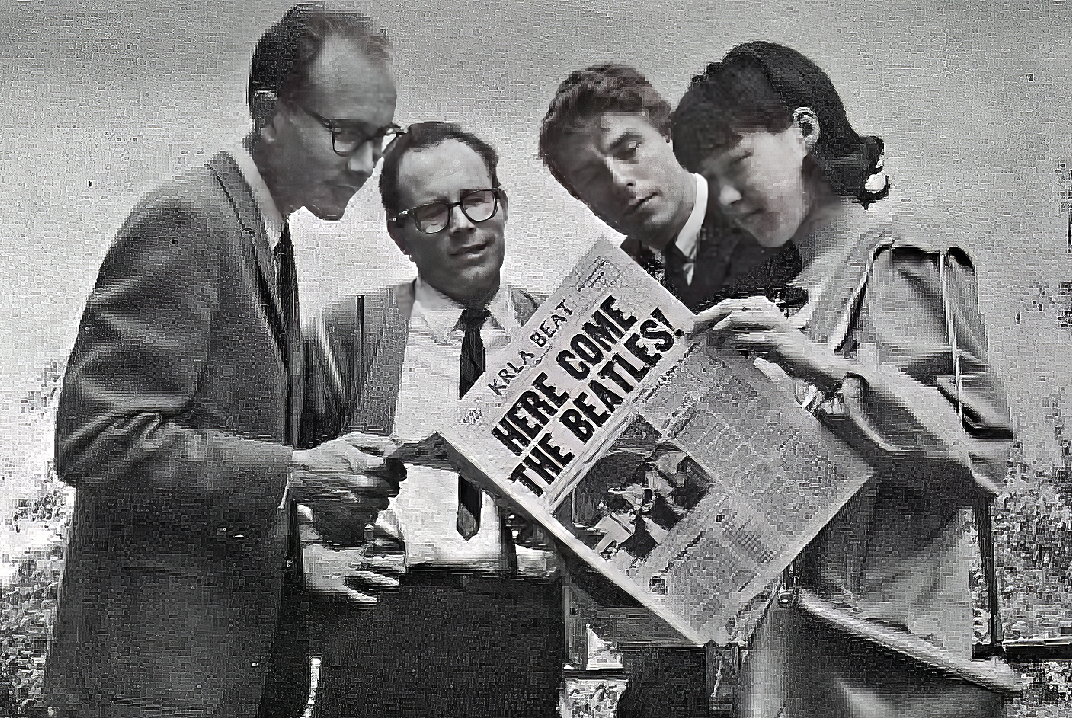
If you like music charts, this is the place to be. The KRLA Beat website is launching the Tunedex page, where each week you can see what was on the KRLA charts in 1964.
In American pop music it was probably the most significant year with the onset of Beatlemania, a phenomenon that had swept England and parts of Europe all throughout 1963. We were behind the times through no fault of our own.
Beatles producer at EMI George Martin had tried vainly all through 1963 to get American distributors such as Capitol Records (which EMI owned) to release Beatles records on these shores. "This is a good one," Mr. Martin urged every time the Fabs had a number one hit in England. Yet Capitol wasn't interested. Labels such as Vee-Jay, Swan, and Tollie stepped in to release the first Beatles records in the United States.
As a result bits and pieces of the Beatles' catalog nevertheless made their way into U.S. airplay: WLS-AM in Chicago, KFXM in San Bernardino, California; WORC in Worcester, Massachussetts; and finally WWDC in Washington DC. Even KRLA got into the game and scheduled "From Me To You" in their playlist in July 1963. But the big blue wave of the British Invasion wasn't quite ready yet.
By January 1964 there was no stopping it, and listeners were already hearing "I Want To Hold Your Hand" on the airwaves across the nation. KRLA was no exception. In fact, they were already geared up for an onslaught, grasping at whatever songs they could find, even British releases that hadn't been distributed yet. Chalk it up to KRLA's perspicacity. They knew a pheomenon when they heard it.
Starting January 11, 2023 you can read each weekly Tunedex online. Come and join the fun!
A revolution from sixty years ago

This week sixty years ago at KRLA the music wasn't half bad. According to this Tunedex transcription from Oldiesloon, you can see for yourself that the mix was partly old masters of rock and roll (Elvis Presley, Ray Charles), new artists such as The Orlons, Little Eva, Dee Dee Sharp, some instrumentals (Herb Alpert & the Tijuana Brass, the Tornadoes, Duane Eddy), a few jazz crossovers (Vince Guaraldi, Stan Getz), and a middle-of-the-road pop hit or two (Steve Lawrence, Nat King Cole).
Unbeknownst to KRLA program directors and deejays, there was something brewing in England, a revolution of rock music that would take a year to reach our shores. On November 26, 1962 four fellows from Liverpool, their roadie Neil Aspinall, their fan club secretary Bobby Brown, and their manager Brian Epstein showed up early for a recording session in London.
The Beatles flew down from Speke Airport. Neil with Bobby drove the van with all their equipment: John's Gibson J160 "Jumbo" acoustic, George's Gretch Duo-Jet, Paul's Hofner bass, and Ringo's Premier drum set. Arriving an hour before their studio booking of 7:00-10:00pm, the group had time to rehearse briefly before launching into the two songs scheduled for recording that evening, producer George Martin at the controls.
At the end of the recording, George Martin legendarily pressed the talk-back and said "Gentlemen, you have just made your first number 1 record." It was true for at least two record charts in the U.K., where "Please Please Me" did in fact reach number one early in 1963.
KRLA was in a great position to take advantage of the coming new wave of music. Dick Biondi, hired by KRLA in mid-1963 after being let go from WLS-AM in Chicago, played a promo copy of "Please Please Me" on the air in February 1963, which actually charted on the WLS weekly Silver Dollar Survey and became the first documented airplay of a Beatles record on the U.S. airwaves. When Biondi came to KRLA in June 1963, "Please Please Me" had peaked, but there was a follow-up, "From Me To You," which officially went to number one in England. Biondi liked the record and encouraged KRLA to add it to their playlist. They did and it appeared on the KRLA Tunedex in July 1963, not making much of an impression, but it was a start. Everyone needs a start point.
Those of us listening to KRLA in November 1962 didn't realize what was imminent, but a year later -- with major TV stations beginning to notice what was called Beatlemania in England -- we were about to experience it ourselves. "Please Please Me" was the Beatles' ticket to the "bright white tomorrow," as preeminent Beatles scholar Mark Lewisohn described their future. "Please Please Me" sounded like nothing that had come before it. The record shook up the British airwaves just as other Beatles records would do in America. KRLA was on the cusp of a musical revolution and to their credit they made the best of it just a year later...to the advantage of us all.
Sie Holliday: a groundbreaking voice at KRLA
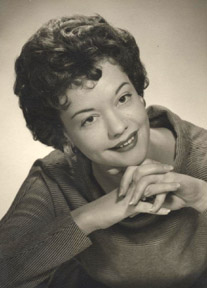
One of KRLA's most adventurous forays into programming was the hiring of Shirley (Sie) Holliday in 1962. Women were not featured as on-air personalities during the 1950s and 1960s, especially in larger radio markets. Holliday was a happy exception, becoming one of the first female deejays in the Los Angeles area.
Born Shirley Schneider in Giddings, Texas in 1930, Holliday was already using her unusual nickname during her college years, where her interests included speech, debate, and radio. Her years at the University of Texas also included activities in drama, the University's Texas School of the Air, and Radio House, a production entity for on-air and local entertainment. She became a staff announcer on local Austin television by 1951, a time when women, if on television at all, were relegated to homemaking shows and similar niche programming.
Holliday's first west coast professional gig was at the San Diego area's one-thousand watt radio station KDEO 910 AM, which had jumped on the top-forty bandwagon as early as 1959. Several KRLA alumni were part of the station's line-up, including Perry Allen, Sam Riddle, and Mel Hall. One or more of her compatriots probably introduced her to KRLA management, where she was hired in May 1962. Holliday's home-town newspaper the Austin American Statesman highlighted her success that month.
It was a tempestuous time to join KRLA, enmeshed as it was in its licensing issues. The local Pasadena press regularly updated its readers on the station's travails. Holliday's unusual but mesmerizing voice, shorn of its Texas twang, was a noticeable highlight on the airwaves, where she had her own show in a variety of time slots. She also acted as traffic director for KRLA alongside fellow deejay Bill Keffury, managing advertising and promotional spots for the station, recording voice-overs where needed, and substituting for absent air talent.
John Gilliland's "Pop Chronicles" provided another voice opportunity for Holliday in 1967. A fellow Texan, Gilliland had worked at KRLA as a newscaster but was inspired by the 1967 Monterey Pop Festival to produce a multi-chapter on-air history of pop music from the 1950s onward. Holliday was one of the show's narrators along with Thom Beck, Lew Irwin, Len Chandler (lending his songwriting skills), and Harry Shearer.
In 1974 the Cal State Fullerton newspaper the Daily Titan interviewed Holliday at some length, which you can read here. She admitted that forging a radio career as a woman wasn't particularly easy, but (said Holliday) "I have never had a problem with the 'public acceptance.' And I was a staff announcer on television long before there were women staff announcers."
Holliday left KRLA in 1976 and returned to Texas to care for her aging mother in 1978, but she remained active in real estate and dabbled in local theatrics. Holliday died in 2006. An obituary details her many accomplishments.
KRLA experiments: Collage
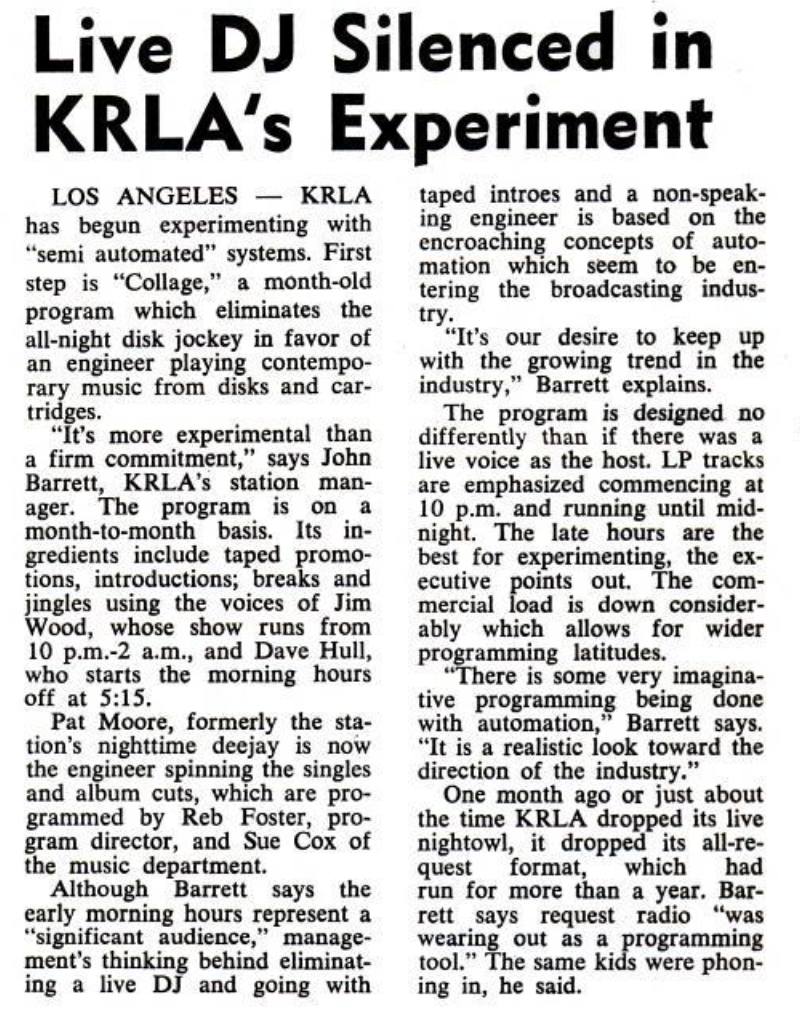
In late 1967 KRLA tried an option highlighting obscure album tracks and experimental music, a precursor to later AOR (album oriented rock) radio formats.
To be honest the station had always played B-sides and non-charting tracks, plus the occasional rarities from the BBC via Derek Taylor. If you were up late at night in 1962 you might hear the evening deejay play some blues in the fifteen minutes up to midnight. In 1966 you might hear the Rolling Stones' "Goin' Home" (eleven minutes thirty-five seconds long) played at the end of a shift.
This may or may not have been a ploy to get the on-air talent out the door a little early, but it was an opportunity for listeners to hear songs they might not have an opportunity to experience otherwise. Those of us with our ears glued to our transistors were glad to have the experience.
In late 1967 John Barrett and his crew decided to further the experiment with Collage, a late-night automated showcase of unusual tracks and musical episodes. It wasn't out of keeping with KRLA's other non-traditional fare, such as Radio Free Oz and Pop Chronicles.
Programmed by program director Reb Foster and music librarian Sue Cox, the show used pre-recorded announcements by deejay staff, including Dave Hull, to introduce its audience to new musical material. Barrett was always pushing the envelope.
But this was probably also a way to experiment with automated programming, piquing the ears of interested listeners and saving money besides. This article is from the November 18, 1967 issue of Billboard Magazine.
Art Laboe 1925-2022
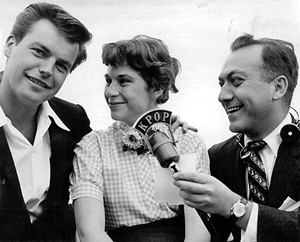
We note with sadness the passing of Art Laboe (born Arthur Egnoian), a deejay who spent a number of years on the air in the Los Angeles radio market, including stations such as KPOP, KXLA (KRLA's previous incarnation), and at KRLA itself from 1979 onward.
His particular genius involved his ability to connect with his audience, from his early KXLA days as a roving deejay through the end of his on-air career. The British newspaper The Guardian has one of the best obituaries I've seen, and it's well worth a read.
If you want to hear what Art sounded like in his early days, well before the invention of his oldies-but-goodies format, check out this page about KXLA, where you can hear an aircheck of Laboe's show from 1951 on KXLA.
He seemed an invincible presence on the air. It will be hard to imagine radio without him.
Putting the "news" in the newspaper
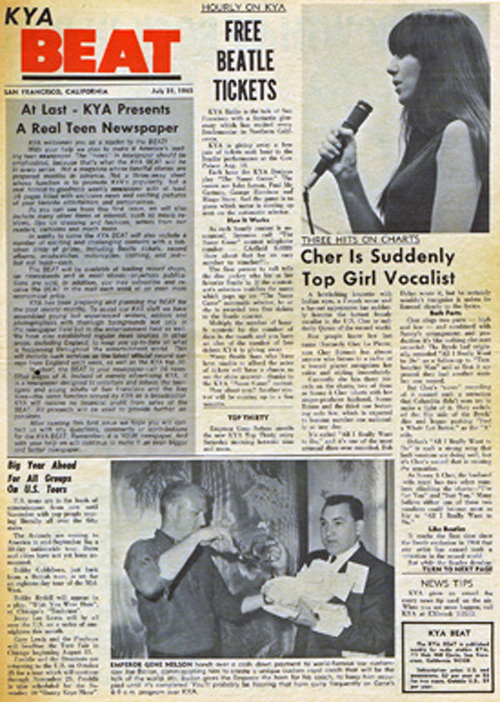
Thanks to Scott at Northern Sky Archive, we have what's close to a mission statement from the KRLA Beat...via its new Bay Area spin-off, the KYA Beat. It's an interesting clue to the new direction. The KYA Beat was just being launched in the San Francisco area, so they had to tell their readership why they were different from all other U.S. music publications. Read the editorial by clicking the image at left.
"The 'news' in newspaper should be emphasized, because that's what the KYA Beat will be in every sense. Not a magazine whose fanciful stories were prepared months in advance. Not a throw-away sheet whose function is to promote KYA's popularity, but a real honest-to-goodness weekly newspaper...."
In the Southern California market the KRLA Beat had already demonstrated this commitment, distancing itself from its "throw-away" predecessor by going to newsprint in February 1965, organizing itself into a real music publication with newly hired reporters and feature writers. KRLA's radio news director Cecil Tuck was clearly a driving force, but so were two new voices joining the Beat community around that time, whose experience with the British pop music scene -- and journalism -- made them particularly authentic additions to the team: journalists Tony Barrow and Derek Taylor.
Both Barrow and Taylor were familiar with British music newspapers such as Melody Maker and New Musical Express, weeklies that also treated music news as serious business. Is it any wonder that the Beat veered towards that more professional model, down to the British-press-inspired red masthead and page layout?
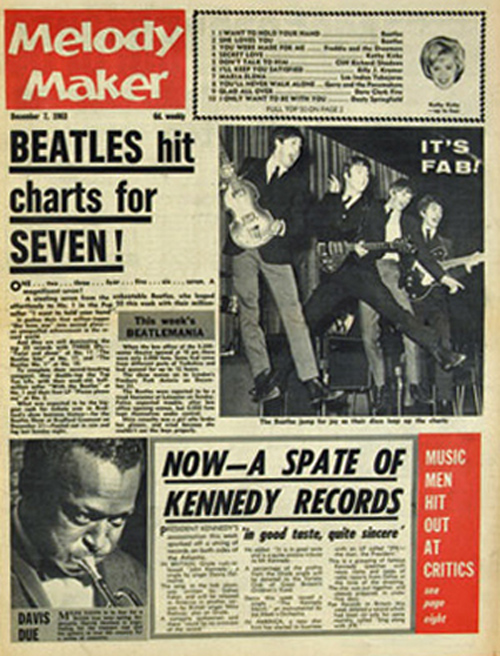
Barrow, originally a Decca Records employee who wrote liner notes for LPs, had written pseudonymous music reviews under the name Disker for the Liverpool Echo, Merseyside's primary newspaper. From 1962 to 1968 he was also employed by Beatles' manager Brian Epstein as the group's press officer. Barrow contributed a weekly column for the KRLA and KYA Beat, focusing on happenings in the British music scene, with occasional special reports on the latest Beatles' recording session.
Taylor's conversion came about when he was assigned by the Manchester Guardian to cover a May 1963 Beatles concert at the Mancester Odeon. Instead of the negative piece his editors expected, Taylor sang their praises. By early 1964 Taylor was ghostwriting a regular newspaper column ostensibly by George Harrison, as well as acting as media liaison for Brian Epstein. Epstein's demanding nature led to Taylor's departure after the Beatles' North American tour in September 1964, which left him a free agent just around the time the KRLA Beat was in its infancy. How lucky for the Beat!
Cecil Tuck's Beat newspaper never quite realized its dream of national pop-music news coverage, but the issues that survive provide a unique window into the evolution of mid-sixties rock and roll, and were the first of their kind in the USA. Not such a bad legacy, really.
For those with a particular interest: the Manchester Guardian was almost the only mainstream British press entity writing about the Beatles in mid-1963 with anything remotely like an intelligent view. Here's a June 3, 1963 article by Stanley Reynolds called "Big Time". In most browsers you can click the jpeg image to enlarge and read it in its entirety.
Something new

Sharp-eyed readers will notice a change in the KRLA Beat website. We've upgraded our look to include a brand-new template that's responsive and clean -- viewable on desktop and laptop computers, tablets, and smart phones.
It's needed a make-over for a long time. An upgrade has been necessary for years to help folks access the site on multiple platforms, which is the way things are done in modern times.
New content has also been added to the Beat Blog, deejay links have been updated, and new sidebar links have been added (with old, defunct links deleted).
Let us know if you encounter any issues. It should be a much easier browsing experience for everyone!
We're not much on fancy words
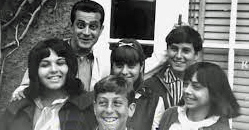
KRLA collector Timmy sent along a nice sound clip of Dave Hull opening his afternoon show with a very local hit record. If I had to guess, I'd say this snippet comes from the 1981 KRLA deejay reunion, but I'd be happy for corroboration.
The band, pictured here with Dave Hull on the KRLA studio front porch, was made up of Suzie Cappetta and her two younger brothers, Michael and Robert, plus two cousins, Gale and Paula Chodkowski. Dubbed "The Scuzzies" by Hull himself, the quintet recorded their paean to Dave, "Dave Hull the Hullabalooer," in December 1964.
The backing group was The Vibrants, the house band at Bob Eubanks' Cinnamon Cinder nightclub, and one of the producers was Don Wayne, road manager of the Everly Brothers. KRLA listeners loved it. The song made it to number 13 on the KRLA Tunedex for March 1965, but if you were a KFWB-only fan you'd have missed it entirely.
The Scuzzies' mysterious lyrical reference to "your junky float" can be clarified in the January 1, 1965 issue of the KRLA Beat, where photos of the Hullabalooer show Dave riding a float in the Hollywood Christmas parade that was made of...junk, most of which had been provided by fans. All Emperor Hudson got was a gold Rolls Royce, poor fellow.
The Scuzzies gave voice to the affection fans felt for their number one KRLA deejay. Dave remained one of KRLA's most popular personalities throughout his station tenure and was always a heavily-requested favorite at local dances and school events.
We miss him! Hard to believe that his definitive autobiography was published in 2012, ten years ago, but you can still track down a copy (hardback or Kindle) online.
Beck Beat
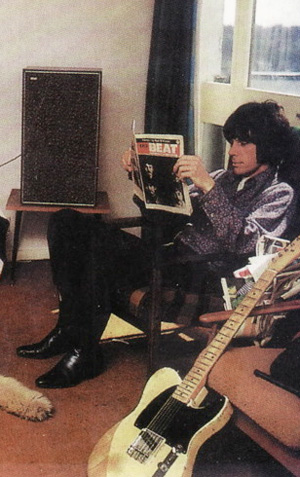
While Jeff Beck was with the Yardbirds he was heard frequently on KRLA, a station with its ear well-tuned towards the more progressive, guitar-driven sounds of the British Invasion. Yardbirds hits like "For Your Love," "Heart Full of Soul," "Shapes of Things," and "Still I'm Sad" were placed in prominent rotation on the KRLA charts. Beck joined the group just after "For Your Love," replacing Eric Clapton on guitar.
Beck's tenure in The Yardbirds provided some of the most exotic sounds on the airwaves at that time, with songs using fuzztone guitar effects and the haunting Gregorian-like chants on "Still I'm Sad." Beck was named Britain's number one lead guitarist by the English magazine Beat Instrumental.
But there were eccentric moments during his tenure with The Yardbirds, including a tendency to be late to gigs or simply not show up at all. Beck was let go after a particularly difficult U.S. tour in October 1966.
Not one to let things get him down, he formed the Jeff Beck Group in January 1967 with Aynsley Dunbar, Rod Stewart, and Ron Wood. The group's sound tended more towards heavy blues and psychedelic pop. They toured the U.K. in early 1967.
At some point, someone snapped a couple of photos of Beck enjoying the March 25, 1967 KRLA Beat, accompanied by his Fender Esquire and the furry paw of an out-of-shot canine friend. Photos of sixties pop stars reading the Beat aren't all that unusual (the Beat had published many), but color shots are rare.
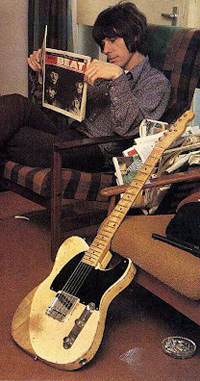
The Beat covered the first Jeff Beck Group in its pages, publishing a letter from him in the January 28, 1967 issue: "Merry Christmas -- even though it's a bit late! As I expect you know, I have left The Yardbirds and am recording with my own group tomorrow. So, I'll be keeping in touch with you and letting you know what's happening for me. Happy New Y ear. Jeff Beck, England." That's nice!
Nevertheless the Beat noted in the April 8, 1967 issue that the group's debut was a "disappointment," without expanding on reasons why this might be so. A month later, in the May May 6, 1967 issue, Beat senior reporter Louise Criscione elaborated a bit more: "According to Jeff Beck's new publicist, Jeff and his new group broke the existing Rolling Stone record at the Marquee Club. Quite a switch from Jeff's debut which ended with his dropping out of the tour. He recently spent time in Los Angeles and then flew back to Britain to open at the Marquee."
That explains how he got his hands on a copy of the Beat. For the record (no pun intended) the "Rolling Stone record" broken at the Marquee Club in London involved attendance at the venue, which previously the Rolling Stones had held.
That's the last we hear of Jeff Beck in the pages of the KRLA Beat. The group had a brief tour of the States in early 1968, making successful inroads in New York City at the Fillmore East as well as San Francisco's Fillmore West. But by that time the KRLA Beat coverage was much reduced due to staff departures and distribution woes. No further note was taken of Beck or his group, although some accounts likened their rapturous audiences to those during the height of Beatlemania.
Casey Kasem and KRLA
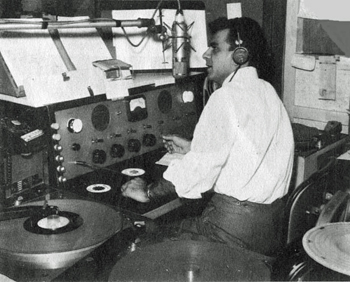
Most people know Casey Kasem's legacy from syndicated radio and television. Those of us fortunate enough to have heard him on KRLA from 1963 through 1969 heard a talent fully formed but somehow approachable and neighborly.
Casey had actually begun his career after being drafted in the Korean War in 1952 where he was on Armed Forces Radio. His professional career was launched on WJRT-AM in Flint, Michigan, then on San Francisco's KYA and Oakland's KEWB, the latter of which was a starting point for several other KRLA deejays.
He didn't have his top-40 countdown in place when he came to KRLA in mid-1963 but his afternoon shows, from noon to 3pm, were always peppered with music trivia involving the artists who sang or produced the songs.
We have a few airchecks that demonstrate Casey's inimitable style on the airchecks page. His tone is warm, friendly, and informative, perfect for an early afternoon. He was the buffer between Ted Quillin's countrified morning effusion and Bob Eubanks' or Dave Hull's more up-tempo post-schoolday freneticism.
For instance, in the October 1963 aircheck you'll hear a nice snippet of KRLA in its pre-Beatles atmosphere, with on-air games and news. How different things were the following July!
Three days
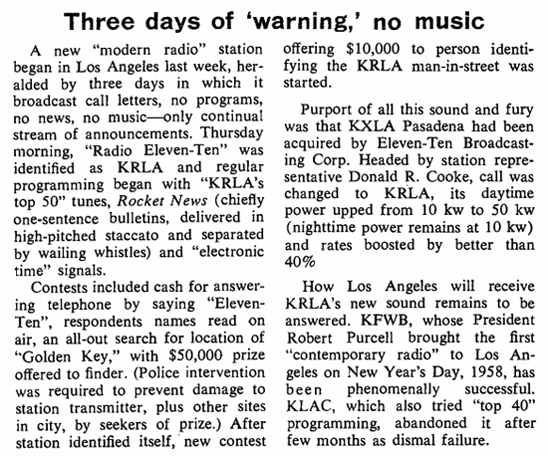
Broadcasting Magazine ran this cryptic news item about a new radio station on the airwaves...or rather new call letters and a brand-new musical focus to go along with the change.
Appearing in the September 7, 1959 issue, it gives the clearest idea of what listeners heard when they tuned in at 1110 kilocycles and found that their Country & Western radio stalwart, KXLA, had vanished.
We know, according to Christopher Sterling and Cary O'Dell's book The Concise Encyclopedia of American Radio that nineteen-year-old Jimmy O'Neill's voice was the first thing broadcast over the new station at midnight on Tuesday September 1, 1959: "You have been listening to KXLA. You are now listening to KRLA -- radio for the young at heart."
For the next three days only the station's new call sign and an unspecified set of announcements filled the airwaves, with regular broadcasting commencing on Thursday September 3.
Whether it was "modern" or "contemporary" or "top 40" radio, Broadcasting Magazine seemed unsure what to call it. As they noted, KFWB had succeeded as Los Angeles' first top 40 station, while KLAC had not been so lucky. There's a sense, from the tone of this article, that Broadcasting's editors felt a second top 40 station in the same market was also doomed to fail.
Of course it was a rocky beginning. But for now, KFWB had a rival on the horizon. Eventually radio mavens would see that Los Angeles was quite capable of handling two, and eventually three, top 40 radio stations. It gave us all more music to love.
KRLA goes to the moon (and back)
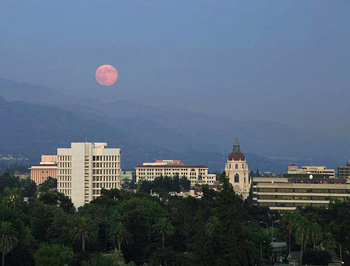
In some ways Pasadena is very different from the way it was forty-nine years ago. More people, bigger buildings, a passel of traffic, a light-rail line. But the moon still rises gracefully over the San Gabriel Mountains just as it did during KRLA's heyday.
On August 20, 1965 a notable event occurred, although almost no one remembers it today. Perhaps its story was overshadowed by the then-upcoming Beatles concert, which would take place three days later at the Hollywood Bowl.
Simply put, for eleven minutes just after midnight, KRLA became the first radio station to have its signal beamed to the moon and back by laser. Engineered by Mark Q. Morgan, then a high school senior at Palmdale High School and organized at the station by program director Mel Hall and deejay Casey Kasem, KRLA's special broadcast could be heard by all who were listening in that night...even ships at sea!
And most remarkably, thanks to the generosity of Mr. Morgan himself, we can have a listen right now.